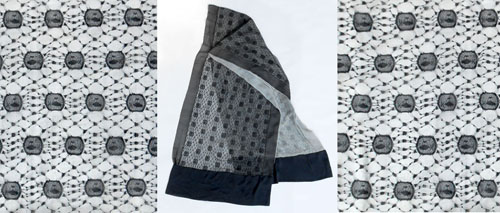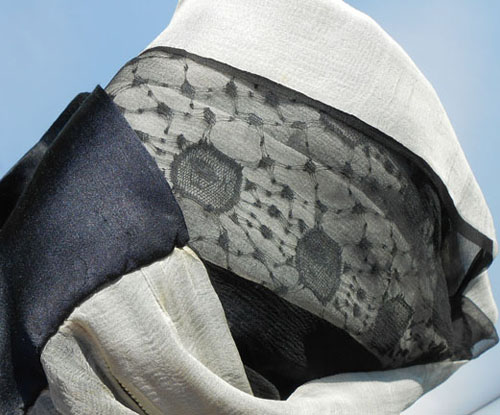 DIRIGIBLE COMMEMORATIVE SILK SHAWL
DIRIGIBLE COMMEMORATIVE SILK SHAWL

Machine-woven black lace backed with ivory silk chiffon, edged with black silk satin, 108” X 26.5”
This shawl is difficult to date because the dirigibles woven into the fabric cannot be identified with absolute certainty. Early flying machines were developed at the end of the 18th century and began to appear in prints and on decorative arts early in the 19th century. However, the dirigible woven into this shawl has a propeller indicating that it was probably made after 1851 when William Bland sent a model of his propeller-powered balloon—”Atmotic Airship”—to the Great Exhibition in London. If the location of the propeller on the balloon woven into the shawl is accurate, the airship depicted could have been taken from an engraving of a hydrogen-filled dirigible from 1865, designed by French engineers Gabriel You and E. Delamarne. The crew powered its propellers and the resulting slow rotation was largely ineffective rendering the airship a failure. The first practical airship, designed by Frenchman Henri Giffard, was launched in 1852. Public fascination with such airships continued into the first decades of the 20th century; in 1901 Brazilian Albert Santos-Dumont won a prize and celebrity for circling the Eiffel Tower, a feat that inspired admirers to wear clothing imitating his Panama hat and other aspects of his fame.

Souvenirs of every imaginable type were produced in great numbers to commemorate, not only the many expositions that proliferated after Prince Albert’s 1851 Great Exhibition, but also for any event that captured the public’s imagination. Folding fans were printed with depictions of buildings at Philadelphia’s 1876 Centennial Exposition. Yard goods were printed with images of the Wright brothers’ 1903 flight. Although this shawl came from an estate that included carefully preserved clothing from the early 18th century through the 1950s, it seems most likely that the shawl was made during the decades between 1890 and 1920.
